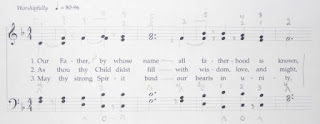In the past two lessons we covered breathing and pedaling. Now it is time to decide on the manual fingering.

Common Tones and Tying
Hymn 296, "Our Father, by Whose Name," begins on C in the soprano, but the next beat has a C in the alto. The next beat has an F in the soprano followed by an F in the alto. If we played the hymn with breaks, it would sound like this:
(Once again, my nails are too long--you can hear them clicking on the keys--don't be like me!)
Instead, we need to remember what was taught in Lesson 8: The Manuals: When the line above is ascending, the notes generally tie. When the line above is descending, the notes generally break." By applying this rule, the hymn will sound like this:
Much better!
Direct Fingering
Before continuing, it may be helpful to review the "Techniques" section of Lesson 8. In order to figure out the fingering for a hymn, it's important to sit down at the organ (or a piano) and work through it. In looking at the first two measures of this hymn, the A is the highest point, and the C the lowest for the right hand. The fingering was simple, so I chose direct fingering for the first line in both hands, as shown (I should have marked lifts in the right hand, too, but overlooked it until after I took pictures):

The second line is identical to the first, so I copied these markings down to the second line. Redistribution of the Inner Part In the third line the fingering is spread out and a bit difficult to play legato, so I decided to redistribute an inner part--all the alto Cs will be played with the left hand, as the brackets show:

I continued the redistribution of the alto Cs through the end of the hymn, and utilized finger crossing in the right hand for the final note:

This technique is difficult for many beginning organists to learn at first, but it is vital to organ playing. Be patient as your fingers and brain learn to think and play in this new way.
Homework
Finish marking hymn 296, "Our Father, by Whose Name." Remember common tone and tying rules. Mark fingerings, ties, breaks, lifts, and anything else that needs to be notated. When marking a hymn remember:
- Use direct fingering whenever possible.
- If you cannot use direct fingering, try redistributing the inner part
- After trying the above, use finger crossing, finger or thumb glissando, or substitution.
Once the hymn is marked, prepare it for accompanying the congregation. From registration to the 15- or 7-step method for leaning a hymn, practice with a metronome and never play faster than you can play perfectly.
In Conclusion
Learning to properly mark a hymn is a very important skill to learn. It opens up the entire hymnal to you.
Continue on to Lesson 17: More on Stops, Couplers, Pistons, and Combination Action.




Very nice. I would love to have one for my baby grand, but VERY expensive!
ReplyDelete